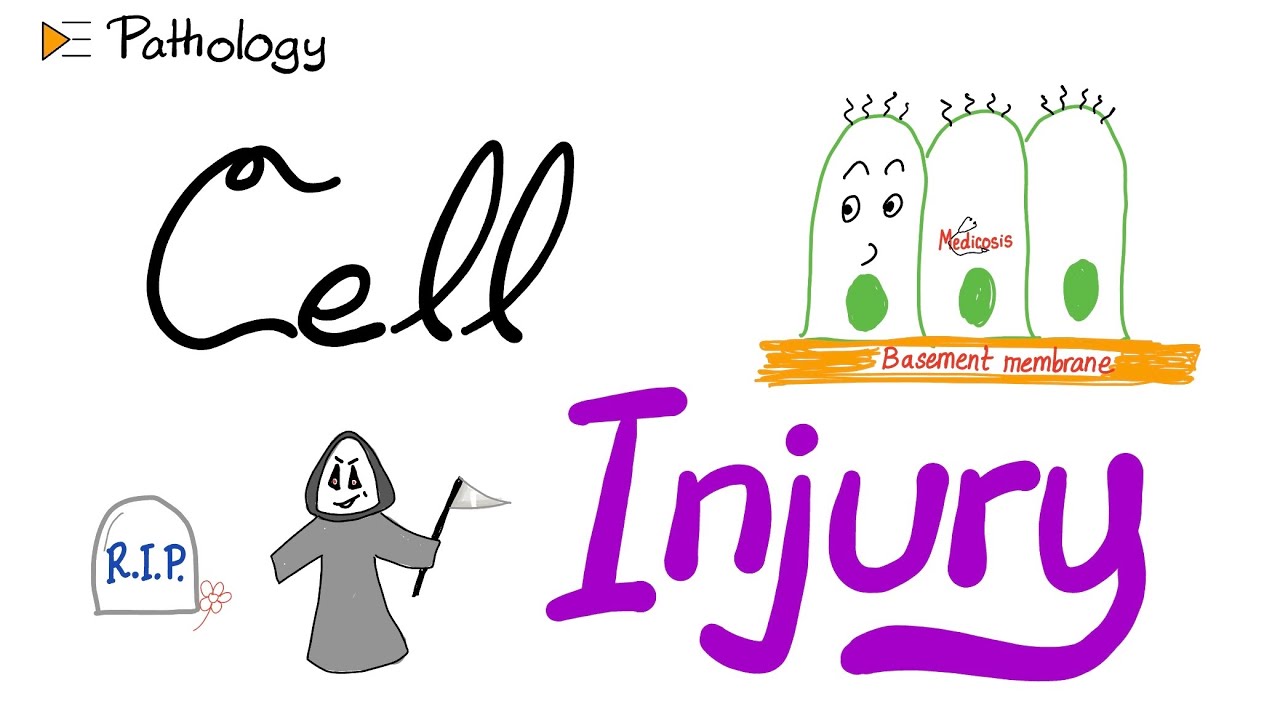Cell Injury and Cell Death. Causes, mechanism and different types of cell injury - part I
Summary
TLDRThis video delves into the concept of cell injury and the mechanisms that lead to cell death. It explains how cells strive to maintain homeostasis but may undergo structural and functional changes when exposed to harmful stimuli. The video covers causes of cell injury, including hypoxia, toxins, and infections, and the four major mechanisms: ATP depletion, mitochondrial damage, calcium influx, and oxidative stress. It also highlights reversible cell injury, such as cellular swelling and fatty changes, alongside the role of cellular adaptation. The video concludes by hinting at the next topic on necrosis and apoptosis.
Takeaways
- 😀 Cells strive to maintain homeostasis, but when unable to adapt to environmental changes, they undergo injury, which can be reversible or irreversible.
- 😀 Cell adaptation types include hypertrophy, hyperplasia, atrophy, and metaplasia, which occur in response to physiological or pathological changes.
- 😀 Reversible injury means that if the damaging stimulus is removed, cells can return to their normal state. Irreversible injury results in cell death through necrosis or apoptosis.
- 😀 Causes of cell injury include hypoxia, ischemia, chemical agents, physical agents, infectious agents, immunological reactions, genetic defects, nutritional imbalances, and aging.
- 😀 ATP depletion is a key mechanism of cell injury, reducing the function of the sodium-potassium pump, leading to cellular swelling and a shift toward anaerobic glycolysis.
- 😀 Mitochondrial damage can lead to reduced ATP production and the release of apoptotic proteins (like cytochrome C), triggering cell death via apoptosis.
- 😀 Increased calcium influx from ischemia or toxins can disrupt mitochondria, activate destructive enzymes, and promote apoptosis.
- 😀 Free radicals (reactive oxygen species) are highly unstable and can damage cellular components such as lipids, proteins, and DNA, contributing to oxidative stress.
- 😀 Membrane damage, including to the plasma membrane, lysosomes, and mitochondria, causes loss of cellular integrity, fluid leakage, and further damage.
- 😀 Reversible cell injury features include cellular swelling and fatty change, which are detectable via light microscopy and occur due to ATP depletion and metabolic imbalances.
Q & A
What is the ultimate goal of every cell in our body?
-The ultimate goal of every cell is to maintain homeostasis, which involves keeping internal conditions stable despite external changes.
What are the four types of cell adaptation mentioned in the script?
-The four types of cell adaptation are hypertrophy (increase in cell size), hyperplasia (increase in cell number), atrophy (decrease in cell size or number), and metaplasia (change from one cell type to another).
What happens when a cell cannot adapt to its changing microenvironment?
-If a cell cannot adapt to its microenvironment, it undergoes cell injury, which can be reversible or irreversible, leading to potential cell death.
How can reversible cell injury be identified?
-Reversible cell injury can be identified by features like cellular swelling, fatty change, distension of the endoplasmic reticulum, detachment of ribosomes, and mitochondrial swelling.
What are the main causes of cell injury?
-The main causes of cell injury include hypoxia and ischemia, chemical agents, physical agents, infectious agents, immunological reactions, genetic defects, nutritional imbalance, and aging.
What is the role of ATP in maintaining cell function, and what happens when ATP levels decrease?
-ATP is crucial for maintaining functions like the sodium-potassium pump, which helps regulate the balance of electrolytes across the cell membrane. When ATP levels decrease, the sodium-potassium pump fails, leading to sodium and water influx and causing cellular swelling.
How does mitochondrial damage contribute to cell injury?
-Mitochondrial damage impairs ATP production and can cause cell death by releasing apoptotic proteins like cytochrome C, which triggers apoptosis. Additionally, mitochondrial permeability transition pores form, further reducing ATP synthesis.
What is the role of calcium in cell injury?
-Calcium influx plays a significant role in cell injury by activating various harmful enzymes, including phospholipases, endonucleases, and proteases, which lead to membrane damage, DNA fragmentation, and protein breakdown.
What are free radicals, and how do they contribute to cell injury?
-Free radicals are highly reactive molecules with unpaired electrons that can damage cellular components like lipids, proteins, and DNA. They are produced through normal cellular processes, radiation, and inflammation, leading to oxidative stress and further cellular damage.
What is fatty change, and why does it occur in certain tissues?
-Fatty change refers to the abnormal accumulation of triglycerides within the cell. It typically occurs in the liver, kidneys, and heart, often due to metabolic disruptions, toxins (like alcohol), or ischemia, and is commonly associated with conditions like metabolic syndrome.
Outlines

This section is available to paid users only. Please upgrade to access this part.
Upgrade NowMindmap

This section is available to paid users only. Please upgrade to access this part.
Upgrade NowKeywords

This section is available to paid users only. Please upgrade to access this part.
Upgrade NowHighlights

This section is available to paid users only. Please upgrade to access this part.
Upgrade NowTranscripts

This section is available to paid users only. Please upgrade to access this part.
Upgrade NowBrowse More Related Video

CAPÍTULO 2 Robbins: Mecanismos de lesión celular (Estrés oxidativo, daño de membrana, 🧬 y proteínas)

Introduction to Pathology - Cell Injury - A New Pathology Series

Jejas, Adaptasi, dan Kematian Selular (Nekrosis & Apoptosis) | Patologi Anatomi 101

3 CLAVES para ENTENDER el CÁNCER

Necrosis | Cell Injury | General Pathology 🩺

Cedera dan kematian sel MK Patologi Farmasi ULM
5.0 / 5 (0 votes)